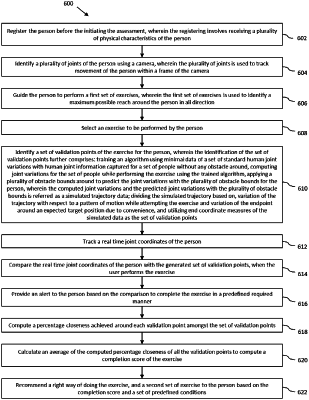| CPC A63B 71/0622 (2013.01) [G06T 7/20 (2013.01); G06T 7/70 (2017.01); G06V 10/751 (2022.01); G06V 40/10 (2022.01); G06V 40/20 (2022.01); A63B 2071/065 (2013.01); A63B 2214/00 (2020.08); A63B 2220/05 (2013.01); A63B 2220/807 (2013.01); G06T 2207/20081 (2013.01); G06T 2207/30196 (2013.01); G06T 2207/30241 (2013.01); G16H 10/20 (2018.01)] | 11 Claims |

|
1. A processor implemented method for assessing and improving wellness of a person using body gestures, the method comprising:
registering the person before the initiating the assessment, via one or more hardware processors, wherein the registering involves receiving a plurality of physical characteristics of the person;
identifying a plurality of joints of the person using a camera, wherein the plurality of joints is used to track movement of the person within a frame of the camera;
guiding, via the one or more hardware processors, the person to perform a first set of exercises as a warmup session, wherein the first set of exercises is used to identify a maximum possible reach around the person in all direction and the first set of exercises is a combination of stretch and walk to know the limits and during the first set of exercises tip joints are tracked to identify the maximum possible reach in all direction;
detecting, via the one or more hardware processors, presence of person in the frame of the camera in which an image is passed through a human part detector model that is trained to detect human body parts in the image and built using transfer learning, the human part detector model outputs a heatmap with same size of the image and computes coordinates of the points of maximum joint detection from the heatmap, wherein an additional layer is added at the output to ensure joint coordinates have better accuracy and stays valid for a human and the additional layer is a classifier used on top of a joint detection model to identify most valid joints;
selecting, via the one or more hardware processors, an exercise to be performed by the person;
identifying, via the one or more hardware processors, a set of validation points of the exercise for the person, wherein the identification of the set of validation points further comprises:
training an algorithm using minimal data of a set of standard human joint variations with human joint information captured for a set of people without any obstacle around the person and validated using standard variation biologically defined for a human,
computing joint variations for the set of people while performing the exercise using the trained algorithm,
applying a plurality of obstacle bounds around to reduce expectation due to limitations faced by the person and to predict the joint variations with the plurality of obstacle bounds for the person, wherein the computed joint variations and the predicted joint variations with the plurality of obstacle bounds is referred as a simulated trajectory data,
dividing the simulated trajectory data in to two parts based on, variation of the trajectory with respect to a pattern of motion while attempting the exercise and variation of the endpoint around an expected target position due to convenience, and
utilizing end coordinate measures of the simulated data as the set of validation points;
tracking, via the one or more hardware processors, a real time joint coordinates of the person to track motions of the person while performing the exercise;
comparing, via the one or more hardware processors, the real time joint coordinates of the person with the generated set of validation points, when the person performs the exercise;
providing, via one or more hardware processors, an alert to the person based on the comparison to complete the exercise in a predefined required manner;
computing, via one or more hardware processors, a percentage closeness achieved around each validation point amongst the set of validation points;
calculating, via one or more hardware processors, an average of the computed percentage closeness of all the validation points to compute a completion score of the exercise; and
recommending, via the one or more hardware processors,
a right way of doing the exercise, and
a second set of exercises to the person based on the completion score and a set of predefined conditions, wherein a monitoring table for the person with completion score, time of action, task name, difficulty level are prepared, wherein for the person first the monitoring table and list of entries for a part of interest is listed, and continues to learn and grow the monitoring table for each task for every user and the monitoring table is timely updated with new data after extracting required insights from the data.
|